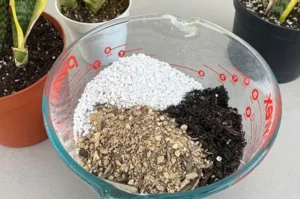If you’re a plant lover, chances are you’ve got a bottle of orchid fertilizer sitting around and a snake plant quietly thriving in a corner. The question is, can orchid fertilizer be safely used on a snake plant?
You can use orchid fertilizer on snake plants, provided it’s diluted properly and applied sparingly during the growing season. Snake plants, known as Sansevieria, are not heavy feeders and prefer gentle, balanced nutrition. Since many orchid fertilizers are mild and water-soluble, they can work as a substitute when used carefully.
Why Orchid Fertilizer Can Work for Snake Plants
Snake plants and orchids might not look alike, but their feeding habits have many similarities. Both plants thrive with light, infrequent fertilizing, and don’t tolerate high concentrations of nutrients.
Orchid fertilizers typically contain a higher phosphorus content to support root health and flower development. While snake plants don’t bloom often indoors, a slightly phosphorus-rich formula can still benefit their underground rhizomes and overall resilience.
Many orchid fertilizers come in liquid form, designed for quick absorption without overwhelming sensitive roots. That makes them a suitable option for snake plants, especially during spring and summer when growth is naturally more active.
If you’re considering using an orchid fertilizer for your snake plant, look for a product with a balanced or mild nutrient ratio like 10-15-10 or 20-20-20. One reliable option is the Schultz All-Purpose Liquid Plant Food, which dissolves easily in water and delivers a gentle nutrient boost without risking root burn.
How to Use Orchid Fertilizer on Snake Plants
When fertilizing snake plants with orchid food, the most important rule is dilution. These plants need minimal feeding to stay healthy, and too much can cause more harm than good.
Here’s a safe, effective way to do it:
- Dilute the fertilizer to ¼ strength compared to what’s recommended for orchids.
- Apply only during the active growing season, typically from early spring to early fall.
- Fertilize once every 4-6 weeks, avoiding winter months when snake plants go dormant.
- Use lukewarm, filtered water if possible to avoid mineral buildup in the soil.
Overfertilizing can lead to salt accumulation on the soil surface, yellow leaf tips, or soft, drooping foliage. If you’ve noticed any of these symptoms in your snake plant, it’s worth reading about common problems and solutions to keep your plant in top condition.
Pros and Cons of Using Orchid Fertilizer for Snake Plants
Understanding the benefits and potential drawbacks can help you decide if orchid fertilizer is a good fit for your snake plant care routine.
Pros:
- Gentle, water-soluble formula reduces the risk of root damage.
- Encourages steady, healthy leaf growth.
- Convenient if you already use it for orchids or other houseplants.
Cons:
- Some orchid fertilizers may lack nitrogen, which is important for lush, green foliage.
- Overuse can cause nutrient buildup, stressing the plant.
- Not specifically formulated for foliage plants like snake plants.
Is There a Better Fertilizer for Snake Plants?
While orchid fertilizer can work, a balanced, all-purpose houseplant fertilizer typically offers a better nutrient profile for snake plants. Products with a 10-10-10 or 20-20-20 ratio deliver equal parts nitrogen, phosphorus, and potassium, supporting both foliage growth and root development.
During my plant care routine, I’ve noticed that regularly cleaning the leaves to remove dust can also enhance nutrient absorption and leaf shine. If you haven’t done this in a while, learn about simple, effective methods to clean snake plant leaves naturally and safely.
Final Thoughts
Yes, but only if it’s diluted properly and applied sparingly during the active growing season. Orchid fertilizer can provide a gentle nutrient boost to snake plants thanks to its mild, water-soluble formula. However, for optimal growth and leaf health, a balanced houseplant fertilizer is usually the smarter long-term choice.
If you do decide to use orchid fertilizer, remember to observe your plant for any signs of overfertilization, like yellow tips or drooping leaves. Adjust feeding habits accordingly and always prioritize moderation.






